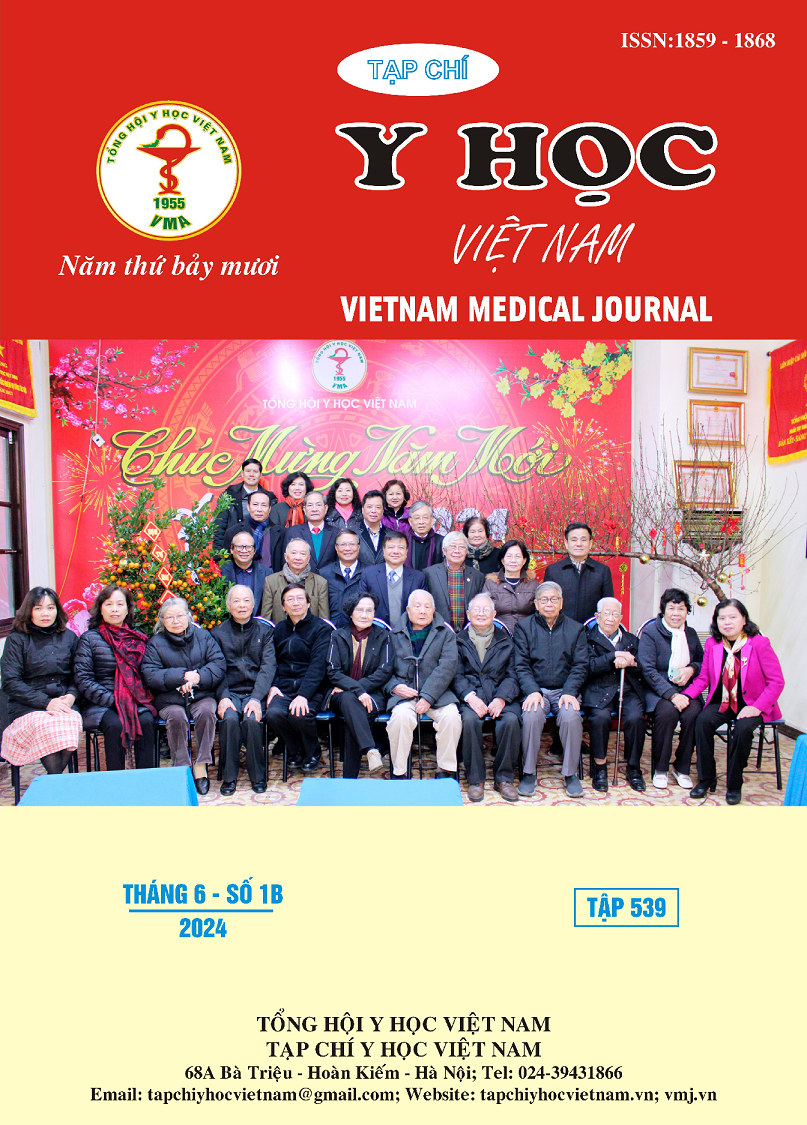ENDOSCOPIC IMAGE AND HISTOPATHOLOGICAL CHARACTERISTICS OF COLORECTAL POLYPS LESS THAN 10 MM
Main Article Content
Abstract
Objectives: To describe the endoscopic image and histopathological characteristics of colorectal polyps less than 10 mm and the relationship between histopathology and some factors. Materials and methods: Cross-sectional study on 168 patients with colorectal polyps less than 10 mm, treated Military Hospital 175, from January 2022 until December 2023. The histopathological diagnosis of colorectal polyps was based on the standards of the World Health Organization in 2000. Results: The average age of patients with colorectal polyps less than 10 mm was 58.77 ± 9.17. The number of patients with colorectal polyps less than 10 mm increased with age. Men accounted for a higher proportion than women, the male/female ratio was 4.99/1. There were 38.7% of patients with solitary polyps. Colorectal polyps less than 10 mm scattered along the colon, concentrated in the sigmoid colon (29.9%) and rectum (22.9%). 84.5% of polyps were sessile and 98.7% of polyps had a smooth surface. Tubular adenoma accounted for the highest rate (53.9%). The rates of hyperplastic polyps and inflammatory polyps were 25.6% and 16.9%, respectively. There were 3.6% of patients with tubulovillous adenoma and no patients with adenocarcinoma. Most polyps had low grade of dysplasia (accounting for 94.4%). There was no relationship between the histopathological classification of colorectal polyps less than 10 mm and the dysplasia grade of the neoplastic polyp with the patient's age, gender, morphology and surface of the polyp. The rate of polyps with high grade dysplasia in the group of patients with solitary was higher than that of patients group with 2 or more polyps, the difference was statistically significant (with p < 0.05). Conclusion: Colorectal polyps less than 10 mm with the presence of tubulovillous adenoma had a higher risk of being cancerous. Solitary polyps had a higher greade of dysplasia than multiple polyps, therefore, close monitoring and resection should be performed
Article Details
Keywords
Colorectal polyps less than, endoscopic images, histopathology.
References
2. Thái Thị Hồng Nhung, Lương Thị Thủy Loan, Nghiên cứu đặc điểm lâm sàng, cận lâm sàng và đánh giá kết quả điều trị bằng phương pháp cắt đốt kết hợp kẹp clip ở bệnh nhân có polyp đại trực tràng tại bệnh viện Trường Đại học Y dược Cần Thơ. Tạp chí Y Dược học Cần Thơ, 2021. Số 40/2021.
3. Chaput, U., et al., Risk factors for advanced adenomas amongst small and diminutive colorectal polyps: a prospective monocenter study. Digestive and liver disease: official journal of the Italian Society of Gastroenterology and the Italian Association for the Study of the Liver, 2011. 43 8: p. 609-12.
4. Galuppini, F., et al., The histomorphological and molecular landscape of colorectal adenomas and serrated lesions. Pathologica, 2021. 113(3): p. 218-229.
5. Loy, T.S. and P.A. Kaplan, Villous adenocarcinoma of the colon and rectum: a clinicopathologic study of 36 cases. Am J Surg Pathol, 2004. 28(11): p. 1460-5.
6. Lowenfels, A.B., et al., Determinants of polyp size in patients undergoing screening colonoscopy. BMC Gastroenterol, 2011. 11: p. 101.
7. Pickhardt, P.J., et al., The Natural History of Colorectal Polyps: Overview of Predictive Static and Dynamic Features. Gastroenterol Clin North Am, 2018. 47(3): p. 515-536.
8. Rex, D.K., et al., Estimation of impact of American College of Radiology recommendations on CT colonography reporting for resection of high-risk adenoma findings. Am J Gastroenterol, 2009. 104(1): p. 149-53.
9. Shapiro, R., et al., The risk of advanced histology in small-sized colonic polyps: are non-invasive colonic imaging modalities good enough? Int J Colorectal Dis, 2012. 27(8): p. 1071-5.
10. Silva, S.M., et al., Influence of patient age and colorectal polyp size on histopathology findings. Arq Bras Cir Dig, 2014. 27(2): p. 109-13.


